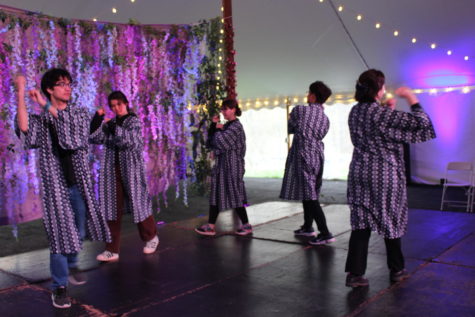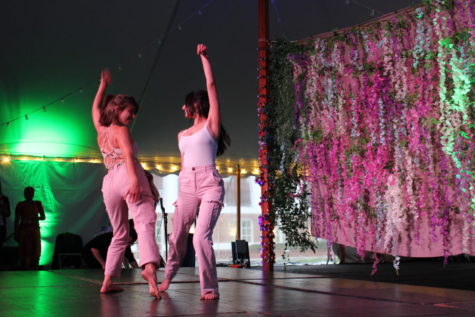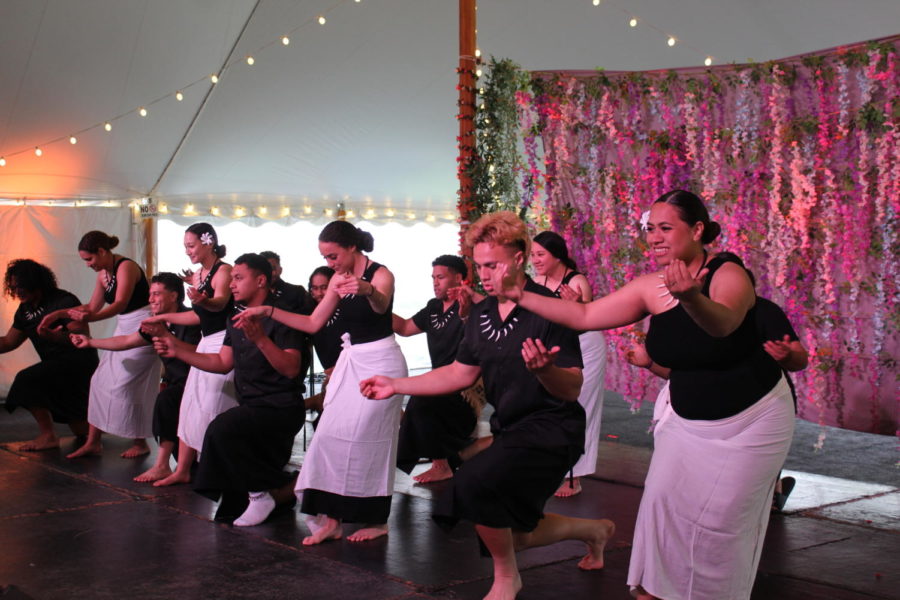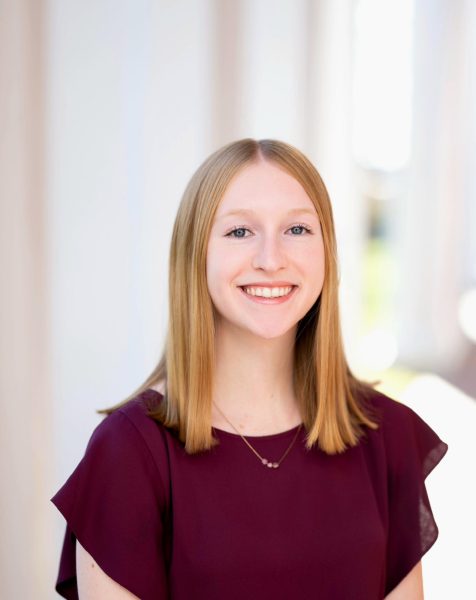Around the Globe hosts spring festival, celebrates culture with dance
The student organization’s first year on campus concluded with a night of music and movement from around the world
Southern Virginia University’s Polynesian Heritage Association performs a Samoan dance. Photo by Emma Malinak ’25
April 11, 2023
Washington and Lee University’s Around the Globe club hosted its second annual spring festival on April 8 to showcase cultural dances.
Around the Globe co-founders Aishwarya Vemagiri, ’25, and Irina Koleva, a ’22 alum, said they wanted the spring festival to give students the chance to connect to their roots and to each other.
“I think we really took this as an opportunity to help build up and strengthen not just the international community, but the community of W&L as a whole,” Koleva said. “Because dance can be such a communal art form, it’s a great way to bring people together to exchange your cultural traditions and teach each other about your personal backgrounds.”
With more international students on campus than ever before, Koleva said multicultural clubs like Around the Globe are increasingly important because they ensure that everyone can make W&L feel like home. While this is Around the Globe’s first year as a student organization, the festival on April 8, attended by over 200 people, showed that it has already established its presence on campus and will continue to provide students with the space to share their traditions.
Audience members were captivated by floral decorations, bright lights, vibrant costumes, upbeat music and unique choreography in the event space on Cannan Green. But Vemagiri, the president of Around the Globe, said the mission of the club goes far past the spectacle of the showcase.
“It’s not just about dance,” she said. “The larger part of it is the connection and support system that’s there. Dance is just one of the facets and avenues we use to help create this connection.”
The rhythm of a community
The club has been focused on this kind of connection since its founding. When Koleva first came to W&L in 2018, she said she noticed that the international student community was small and didn’t have many events through which they could connect. Because Koleva was born in Bulgaria and has danced traditional Bulgarian folk dance for her whole life, she knew she wanted to form a club that used dance to help students learn about each other’s cultures.
At the end of the 2022 winter term, Koleva organized a dance showcase called “Around the Globe” for students to perform cultural dances. Vemagiri was one of about 100 attendees at the event, and she saw that Koleva’s vision had the potential to be a full student organization with multiple showcases and workshops throughout the school year. By the end of the 2022 spring term, Vemagiri got Around the Globe to be recognized as a club by the Executive Committee.

Since then, Koleva said, she and Vemagiri have worked to ensure that every student feels like they have a place on their dance floor.
“I know that the international students have their community, but over the past five years, it’s been growing and it’s been developing,” Koleva said. “And I think Around the Globe, especially this year, has played a role in letting people explore and share their way of life and their culture and feel connected to home in a place that can feel very disconnected.”
International student advisor Hunter Swanson said there are 137 international students at W&L this term from over 50 different countries, which is a reflection of the steady growth in the percentage of international students at W&L in recent years.
Center for International Education coordinator Erin Weyen said that all W&L students will benefit from this growth in the international community because the student body is becoming more globally minded.
“I think it’s great to have more international students on campus at Washington and Lee University, mainly because it’s going to mirror sort of how the rest of the world looks,” she said. “It’s so important to talk to people and interact with people that are not like you so that you just get a better understanding of the human perspective and our human shared experience.” But not every W&L student has stepped out of their comfort zone as Weyen recommends, and Koleva and Vemagiri said that it has been difficult to reach more than just a few subsects of the W&L student body at a time.
Getting people onto the dancefloor
Arhana Sethi, ’26, a performer at the spring festival and an executive member of Around the Globe, said she would appreciate a more diverse audience so that she can share her culture with as many people as possible.
“I do know that a lot of American students don’t usually show up for these international cultures,” she said. “But I do think it will mean a lot if we have more attendance.”
Koleva and Vemagiri have tried to expand their programming to all parts of the student body by creating three branches of their organization.
The first branch collaborates with other clubs so that they can incorporate dance into their events. So far, Around the Globe has partnered with Comunidad Latina Estudiantil (CLE) for the “Baile” event, the Student Association for International Learning (SAIL) for the Parents and Family Weekend fashion show and other student organizations for events throughout the year.
Koleva said this outreach is important because of the unique elements that dance can add to an already-existing event.
“I really think that different dance styles are a little time capsule for what a generation and a culture is going through,” Koleva said.

The second branch of Around the Globe’s programming manifests in workshops designed for students to learn the basics of a cultural dance from an expert. Vemagiri said teaching dance is equally as important to the club’s mission as the performances themselves.
“I really think what it comes down to is just cultivating a respectful and safe space where everyone is under the mutual agreement that we’re all trying to celebrate each other, highlight each other, learn from each other,” she said.
This year, the club has hosted workshops in Bollywood, Japanese Bon Odori and more.
These styles and numerous others were incorporated into this year’s spring festival, a showcase that acts as the third aspect of Around the Globe’s programming. Around the Globe executive member Joe Lee, ’26, who grew up in Korea and China, said showcases are an important way for students to feel in touch with home.
“Especially in a place like Washington and Lee, there isn’t that much either food or cultures that are represented in this area. So I do feel some homesickness or cultural sickness in a sense,” he said. “But I feel like events like this allow me to get exposed to more cultures while also getting me reminded of my own culture as well.”
Festival helps international students connect
Tickets to the festival were free because Koleva wanted the event to be accessible by everyone. Attendees ate ethnic food while watching dances from every corner of the world, ranging from a semi-classical Indian dance to a traditional Irish step dance. Some attendees joined the dances as well, especially when Aislinn Niimi, ’24, taught the audience the steps to a Bon Odori routine.
W&L students weren’t the only performers to take the stage on Saturday. Koleva invited dancers from her hometown in Pennsylvania to perform a Bulgarian folk dance, and Southern Virginia University’s Polynesian Heritage Association presented choreography from six different islands.
Sethi, who grew up dancing Bollywood in New Delhi, India, said the showcase gave her a chance to connect to her roots.
“It makes me miss home a little bit less,” she said. “And it really gives a sense of community to the international students.”
Weyen said this sense of community can be crucial for international students, especially as they adjust to college. She explained that it can be scary for any student to start college, but international students have many more adjustments to make than U.S. students, including getting a visa, learning how to file U.S. taxes, finding a health care plan and getting work authorization.
After conducting research in spring 2021, Swanson found that the most important factor in international students’ adjustment to and belonging on campus is the feeling that the institution supports their culture. Because W&L demands a high level of thinking and learning, Swanson said, international students need to feel supported before they can start to accomplish what is expected of them.
“To reach what’s enshrined in the mission statement of the university, students need to at least find a modicum of belonging on campus,” he said.
Through his research, Swanson found that clubs like CIE, SAIL, African Society, Around the Globe and more are “all the sorts of things that make you feel like the institution is representing your culture” and make international students feel like they belong.
Sethi said that multicultural clubs have helped her adjust to life in Lexington.
“We do have a very small international community here, but I feel like these organizations are really trying to make us feel at home,” she said.
In the future, the leaders of Around the Globe said they hope to expand their programming into the surrounding community to make even more areas feel like home for international students.
“It’s really great to see that web being built, those bridges being constructed. And hopefully, it just keeps getting stronger,” Koleva said. “We really want to be a bridge between the W&L community and Lexington and Rockbridge County as a whole because it’s not just W&L that has a lack of cultural arts education that’s accessible.”




